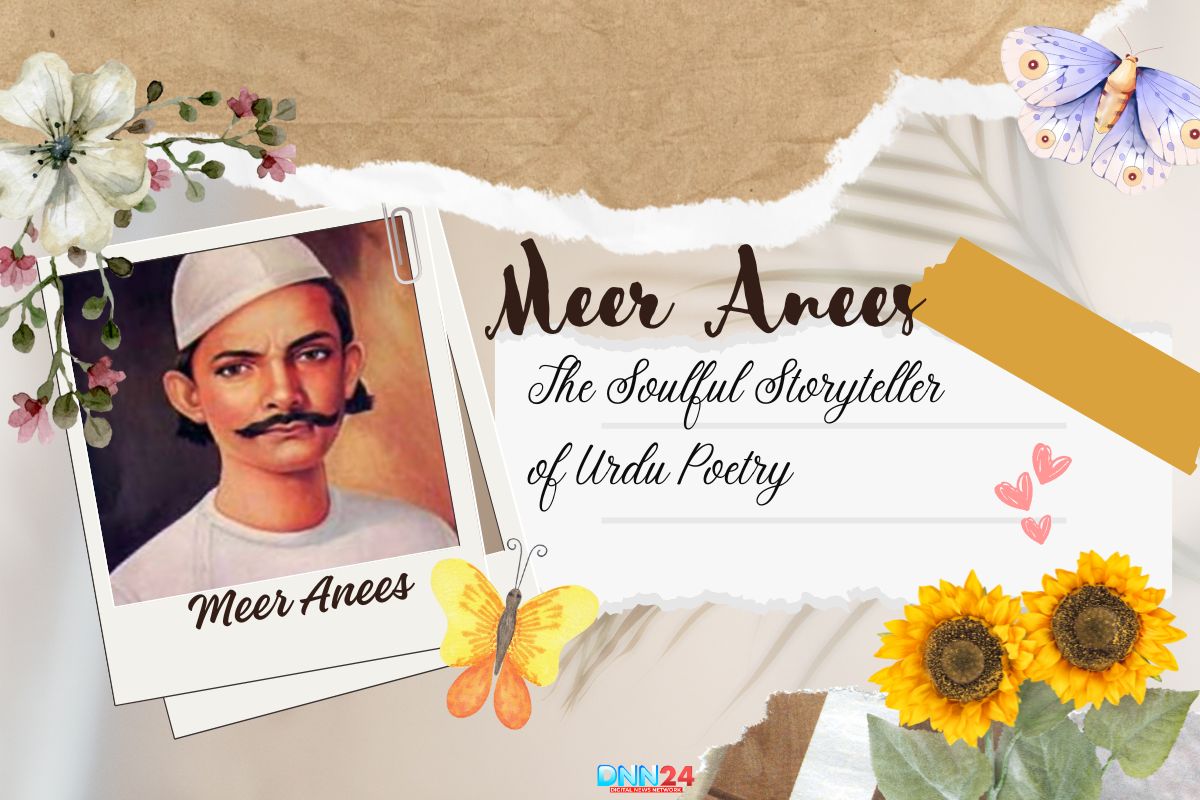Meer Babar Ali Anees, lovingly known as Meer Anees, was born in Faizabad in 1803. Five generations of family poets made his household a rich place for poetry. Poetry came to him as easy as breathing. Anees started writing poems as he mourned his favorite goat at only six years old; this compassionate beginning was just the start of his explored emotions and words.
His father, Mir Khaleeq, was a master of martial (elegy), and his grandfather, Mir Hasan, was celebrated for his massive. Anees would sit outside as the older family members recited verses, and his dreams would excite him. Poetry was more than just a form of art in his home; it was something he lived, prayed, and felt daily.
Namak-E-Khwaan-E-Takallum Hai Fasaahat Meri
Meer Anees
Naatqein Band Hain Sun Sun Ke Balaaghat Meri
Rang Udte Hain Wo Rangeen Hai Ibarat Meri
Shor Jiska Hai Wo Darya Hai Tabeeyat Meri
Umr Guzri Hai Isi Dasht Ki Saiyaahi Mein
Paanchvi Pusht Hai Shabbir Ki Maddaahi Mein
Meer Anees started life in a rustic yet lovely way. Faizabad’s fragrant gardens, the lullabies sung by his mother, and the philosophy in his father’s couplets all greatly impacted him. Ever since he was young, he has been aware of the challenges of losing and of the inspiring words that can transform, and this knowledge made him special.
The Road to Lucknow: Getting to a New World of Inspiring and Meaningful Poetry
By 1842, the Ahmads moved to Lucknow, the center of Awadh, and poetry and culture flourished there as never before. In Lucknow, nawabs ruled, grand imambaras could be found, and nights were filled with recitations. People who recognized the strength of his words and the special spirit he captured discovered him here.
His father advised him to practice Marcia, the elegy that treated poetry as a duty to religion and others. Anees took in what the audience said, and his version of the Marsia grew to be the musical centrepiece of Muharram gatherings. His words clearly described the tragedy at Karbala, while love, sacrifice, and courage were glorified as well.
KHak se hai KHak ko ulfat taDapta hun ‘anis’
Meer Anees
karbala ke waste main karbala mere liye
Anees’s poetry united the past with the present and sadness with hope. Lucknow welcomed him warmly, and he returned this love by introducing the city to a language of love that was simple, from the heart, and timeless.
Marsia uses language to express various feelings.
Marsia: The Spirit within Anees’s Poems
Meer Anees’s name is forever linked with Marsia, the poetic narration of the tragedy of Karbala. Rather than just reciting poems of sorrow, Anees turned the idea of Marcia into a way to remember and appreciate bravery, loyalty, and compassion. His poems were complete of feelings, sometimes gently touching hearts while others were like a flood.
His poems blended Persian, Urdu, Arabic, and Sanskrit words, so his writings were a mixture of various backgrounds1. Usually, his Marcia opened by praising life, developed into talking about the sadness of death and concluded by giving hope and faith. Anees used a unique method—her poems were straightforward but intense, equally emotional, and thoughtful.
tamam umr isi ehtiyat mein guzri
Meer Anees
ki aashiyan kisi shaKH-e-chaman pe bar na ho
Everybody, Muslim and non-Muslim, began to compose marsias because of Anees’s influence. People were reminded by his sayings in every meeting of the value of loving others and being ready to sacrifice.
Anees’s life beyond the poems she collected: Her unheard stories.
Kissey from The Poet’s Life: Tales Not Yet Told
Beneath the spotlight and the fame, the stories of Anees’s life were mostly hidden from many. When he was young, he wrote a marsia for the women in his house to make them happy after something they had lost. His virtues were his sincerity and his ability to feel empathy for others.
Tamaam umr jo ki hum se be-rukhi sab ne,
Meer Anees
Kafan mein hum bhi azizon se munh chhupa ke chale
His pen name is the subject of a less widely known story. Initially, he signed his poems with the name Hazeen, which stands for sad. Ustad Nasiq, a famous poet, suggested after hearing his marsia that Nurbakhsh use the name Anees and this name stayed forever. Accepting it, Anees found himself preparing to support every person facing loss.
Gul-dasta-e-maani ko naye dhang se baandhun,
Meer Anees
Ik phool ka mazmun ho to sau rang se baandhun
The 1857 rebellion saw the British destroy both Anees’s house and his father’s imambara. He entered Kakori to take shelter until the situation cooled down when he returned. Because of these hardships, his poetry became richer, had deeper meaning, and felt more soulful.
Anees’s Shayari: Lifeblood of Emotions
The Enchantment of Anees’s Couplets
Meer Anees’s Shayari is a garden of emotions—each couplet a flower, each word a fragrance. His poems describe love, loss, hope, and faith in words anyone can read. He thought that the heart was where true poetry had its most significant influence.
Anees’ aasan nahin aabaad karna ghar mohabbat ka,
Meer Anees
Ye un ka kaam hai jo zindagi barbaad karte hain
The meanings behind Anees’s words are more profound than they look. He shows us that loving brings pain and means living life.
The Nazm of Meer Anees: A Romantic Journey
Nazm refers to The Song of the Heart.
While Anees is celebrated for his marsia, his nazm (poem) is a different world—gentle, romantic, and philosophical. In his nazm, Anees talks about the loveliness of life, the unknowns of existence, and the yearning. His words have the comfort of raindrops, making the soul friendly again and making us remember old dreams.
Anees’ dam ka bharosa nahin, thahar jao,
Meer Anees
Chiragh le ke kahan saamne hawa ke chale
Many of his poems deal with human hopes, the transience of life, and people’s efforts to find meaning. His verses show a sweet love for beauty, love, and the lasting. The rules for Anees’s nazm are flexible. Sometimes, writing is effortless and flows smoothly; other times, it comes to a standstill as if taking a breather. Every verse has a tale, a dream, and a wish.
Garmi se muztraib tha zamaana zameen par,
Meer Anees
Bhun jaata tha jo girta tha daana zameen par
His nazm is about the joy of living, the way emotions move, and the subtle expression of love. It is simple yet captivating, just like Anees.
The life of Anees: An immortal partner
The Power of Nearness in Anees’s Poems
Meer Anees passed away in 1874 in Lucknow, but his poetry lives on, echoing in every heart that has known love or loss. His maqbara (tomb) is a place of pilgrimage for lovers of poetry, a silent witness to a life spent in service of words and emotions.
Laga raha hoon mazameen-e-nau ke phir ambaar,
Meer Anees
Khabar karo mere khirman ke khosha-cheenoñ ko
He is remembered not only through his works but also by how people cry in Muharram, laugh at gatherings, and think quietly. Anees taught us that true poetry touches us and that being true to each feeling is more important than rhymes.
The Friend of Every Heart is the main point of the essay.
Meer Anees was more than a poet; he was a healer, a friend, a guide. The pattern of his life united emotions such as love, pain, hope, and faith. Pain and loneliness are powerless against the gentle waves of his moving poetry.
Khaak se hai khaak ko ulfat, tadapta hoon ‘Anees’,
Meer Anees
Karbala ke vaaste main, Karbala mere liye
It is in simple phrases from Anees that we sense the greatest truths. When we read his poetry, we recognize parts of ourselves. His nazm shows us the strength to hope, care, and keep living.
Also Read: Amir Khusrau: Poet, Mystic, Musician, and Cultural Icon
You can connect with DNN24 on Facebook, Twitter, and Instagram and subscribe to our YouTube channel.

